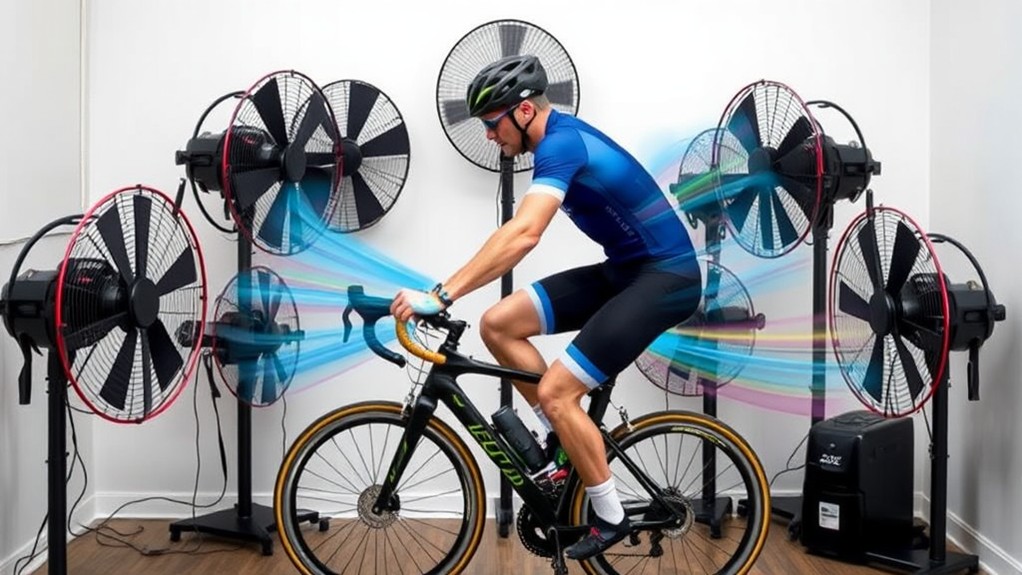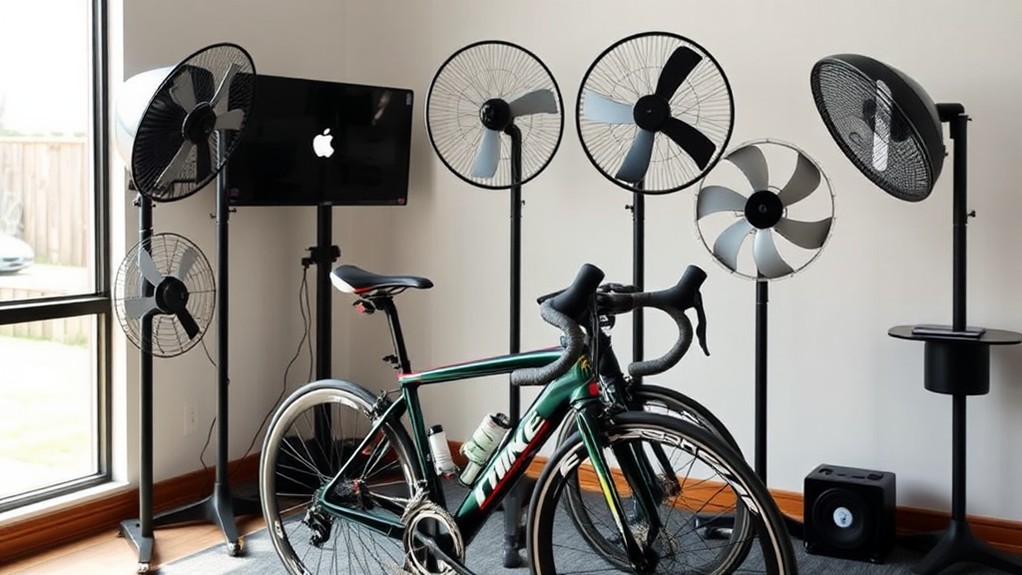For effective turbo training, you'll generally want at least two high-powered fans. One fan can provide broad airflow coverage, while a subsequent targeted fan allows you to customize cooling for specific needs. Position the fans at wheel height and angle them to direct the air across your body for optimal cooling. Remember, individual cooling requirements can vary, so you may need to experiment with fan placement and airflow to find the perfect setup for your training sessions. Keep reading to plunge deeper into the key considerations for choosing and positioning your turbo training fans.
Assessing Cooling Requirements
To determine the appropriate cooling setup for your turbo training sessions, you'll need to assess your personal cooling requirements. The minimum fan output needed indoors to replicate outdoor conditions is around 7500 CFM, which is crucial for effective cooling during intense workouts.
However, individual cooling needs can vary considerably based on your personal preferences. Some cyclists may require higher airflow to prevent overheating and maintain their performance, while others may be comfortable with lower fan settings.
Positioning fans at wheel height and angling them correctly can optimize airflow across your body, enhancing cooling efficiency during your workout.
Using two fans may be advisable for customizable airflow management, particularly if you sweat heavily during low efforts, indicating a need for improved cooling setups.
Environmental factors, such as room temperature and humidity, can likewise influence the required airflow, so it may take some trial and error to determine the optimal fan arrangement for effective cooling.
Evaluating Fan Specifications
When selecting fans for your turbo training setup, evaluating key specifications can help guarantee effective cooling during intense workouts.
The Honeywell HT-900 offers a compact design, but its 312m³/h airflow may be weaker than more powerful options. In contrast, the Wahoo Kickr Headwind fan automatically adjusts airflow based on your speed or heart rate, providing tailored cooling to meet your needs.
Noise levels are also important to take into account, as fans exceeding 60 dB could potentially disrupt your audio experience.
For improved airflow coverage, it's recommended to use multiple fans positioned strategically around your setup, especially for high-intensity sessions.
- Take into account fan types with adjustable speeds or automatic airflow adjustment to personalize your cooling.
- Look for airflow measurements of at least 7500 CFM to replicate outdoor conditions indoors.
- Prioritize quiet operation, aiming for models under 60 dB to maintain an uninterrupted training experience.
- Use a combination of fans positioned thoughtfully to guarantee thorough cooling during your turbo training workouts.
Positioning and Airflow Considerations

Proper positioning of fans is crucial for maximizing airflow and cooling efficiency during intense turbo training sessions.
Positioning fans at wheel height helps direct the cooling breeze directly onto the rider, enhancing the cooling effect. Placing fans to the sides, rather than directly in front, can prevent sweat from dripping onto your expensive equipment, keeping your training area clean.
For optimal cooling, it's recommended to use two fans – one to provide broad airflow across your body, and another to target specific areas like your face and neck.
The effectiveness of a fan's airflow is typically measured in CFM (cubic feet per minute), with a minimum output of around 7500 CFM suggested to replicate outdoor conditions for adequate cooling indoors.
Noise and Energy Efficiency
Noise levels for fans can range from a whisper-quiet 41 dB to over 67 dB, which is comparable to a vacuum cleaner's sound. This variation in fan noise can greatly impact your training experience, potentially disrupting audio from media devices during intense workouts.
When selecting a fan for your turbo training setup, take into account the following:
- Quieter models like the Honeywell HT-900 are excellent choices if you prefer a more peaceful environment, allowing you to fully immerse yourself in your training sessions.
- However, high-speed fans with over 67 dB of noise may be more suitable if you need maximum airflow to stay cool during intense workouts.
- Balancing your airflow needs with your noise preferences is vital to guarantee an enjoyable and distraction-free training experience.
Energy efficiency is another significant factor to take into account. Fans with lower wattage consumption, like the Princess Silver LED Bladeless Fan operating at around 1p/hour, can help reduce your electricity bills over time.
Proper maintenance, such as regular cleaning and lubrication, can likewise improve energy efficiency and prolong the lifespan of your fans, guaranteeing consistent performance during your turbo training sessions.
Adapting to Indoor Conditions

Positioning fans at wheel height and angling them correctly can boost cooling efficiency, with side placement recommended to prevent sweat from dripping onto your equipment.
Using multiple fans allows for customizable airflow management, which can elevate comfort and performance during extended training sessions.
Remember, proper humidity control and temperature regulation are equally key for adapting to the indoor environment.
With the right fan setup, you can create a comfortable and effective training space, no matter the weather outside.
Maintenance and Longevity
Maintaining your fans is crucial for guaranteeing their longevity and optimal performance. Regular cleaning of the fan blades and grills keeps dust at bay, maintaining efficient airflow and preventing any hindrance to cooling.
Don't forget to check the cords and plugs for any damage – this guarantees electrical safety and extends the lifespan of your fans, reducing the risk of short circuits.
- Lubricate the moving parts as needed to reduce friction and noise, enhancing the fan's performance and prolonging its operational life.
- When not in use, store your fans in a cool, dry place to prevent wear and tear, so they remain in excellent condition for future use.
- Test the functionality of your fans regularly, monitoring airflow consistency and noise levels, to catch any potential issues before they impact performance.
Frequently Asked Questions
How Much Space Do You Need for a Turbo Trainer?
You'll need at least a 6 by 6 foot space for your turbo trainer to guarantee proper ventilation and clearance around the setup. Additional space may be required for accessories and multiple fans to maintain optimal cooling.
How Many Fans Do You Need for Good Airflow?
You'll need two high-quality blower fans strategically placed for optimal airflow efficiency during turbo training. Proper fan placement near the wheel can greatly improve the cooling effect and optimize your comfort.
How Do I Keep My Turbo Trainer Cool?
To keep your turbo trainer cool, use strategic fan placement and cooling techniques. Position fans at wheel height and to the sides to optimize airflow and prevent sweat from dripping onto your equipment during intense workouts.
How Do You Train on a Turbo Trainer?
When training on a turbo trainer, focus on effective techniques like interval training to enhance endurance and speed. The turbo trainer's benefits allow you to train indoors, regardless of weather conditions, for a structured and performance-enhancing workout.
